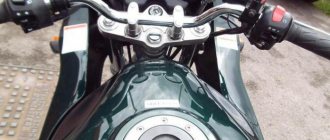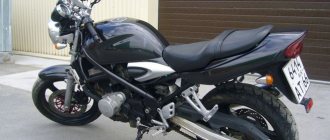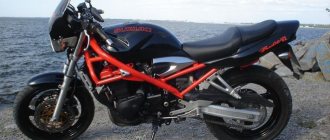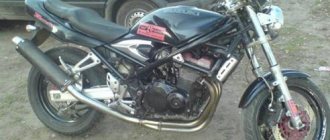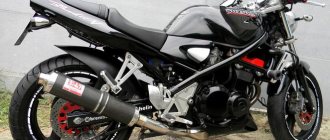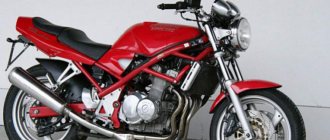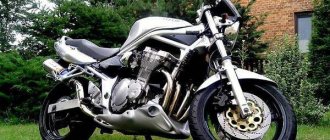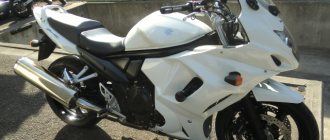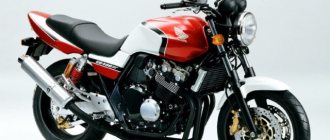The Suzuki GSF 250 motorcycle, the youngest representative of the “Bandits” line, is also one of the last representatives of the small-capacity class with 4-cylinder engines. Despite its impressive characteristics, it was after its production that the Suzuki company decided that other engines, with 1 or 2 cylinders, should be installed on small bikes in order to save money and increase service life. They don’t make motorcycles like this anymore, which is a pity... But this review of the 250 cc Bandit will reveal the strengths and weaknesses of this model.
Specifications
For its time, the bike was simply magnificent. In parallel with it, competitors from other brands were produced, so Suzuki could not afford to lose to them, and they did not save on the cost of the motorcycle. As a result, the Suzuki Bandit 250 has very impressive technical characteristics for a small-capacity vehicle.
Engine
Walk - just walk! Apparently, this is what Suzuki engineers said when they installed a 4-cylinder, 4-stroke liquid-cooled engine (and the “red-headed” modification even received a variable timing system). The results impressed everyone - acceleration to 100 km/h was 7 seconds , and maximum speed was as much as 180 km/h . The engine loves high speeds, and peak power is 45 hp. occurs at around 14,500 rpm , and the peak torque of 25 Nm is at 10,500 rpm . In the lower rev range, thrust is sluggish, a consequence of the small displacement of the Bandit 250 engine.
Transmission
Suzuki Bandit received a classic 6-speed gearbox with very short first gears. When driving dynamically, you can generally switch immediately from first to third, and from third to fifth - the bike reacts to this normally. The gearbox is reliable, and its settings are fully consistent with the technical characteristics of the motorcycle as a whole.
Chassis and brakes
The bike was based on a steel frame with a steel pendulum (later replaced by an aluminum one). The front telescopic fork has no adjustments, but the rear monoshock absorber has as many as 7 positions for preload . The brakes are mediocre, with a 2-piston caliper and 310mm disc at the front and a 250mm disc at the rear with the same caliper. The braking distance of the Suzuki Bandit 250 at maximum speed cannot be called short, so you need to drive carefully.
Electronics
The Suzuki Bandit does not have any complex electronic components. Transistor ignition, battery, analogue instrument panel - that's probably all.
Weight and dimensions
In terms of dimensions, the Bandit GSF 250 is comparable to any 400 of those years; it cannot be called too compact. But it was also created for the Japanese domestic market, and was designed for short, middle-sized Japanese, so it will be cramped for tall bikers. But it weighs a little, dry weight does not exceed 146 kg . Quite a lot for a small-capacity car, but the Suzuki Bandit was created three decades ago, and then technical progress had not yet advanced as far as it does today.
Controllability
Thanks to its modest weight, thoughtful weight distribution and overall successful design, the Bandit 250 motorcycle is very easy to control. But at first it will take some time to get used to its nervous character - the engine reacts sharply even to a slight turn of the throttle, especially at the bottom.
Fuel consumption
The officially declared fuel consumption is about 2 liters of AI-92 at a speed of 60 km/h. In real conditions, the motorcycle is voracious, and it consumes up to 6 liters of gasoline per 100 km , or even more.
Competitors Suzuki GSF250 Bandit
The main competitors in the motor market for the Bandit were and remain the Honda Hornet, Yamaha Zeal and Kawasaki Balius with similar engine sizes. What is the difference between them and why is the Suzuki Bandit considered one of the most successful models?
Kawasaki is not inferior to Suzuki in any respect and even surpasses it in speed. Excellent brakes and fast acceleration make it one of the best in handling and movement in high-speed traffic. A more rigid chassis allows you to ride calmly even on slightly rough terrain. Having such advantages, Kawasaki loses only in a big name. And if the “Bandit” has long become a legend and the talk of the town, the Kawasaki Balius cannot boast of such popularity.
But the Honda Hornet is a more modern representative of 250 cc motorcycles. A bright and stylish road motorcycle with bare-bones details is not inferior to the Bandit in design. The same cannot be said about the internal characteristics. The Honda has a 2-cylinder engine, which is inferior to the one installed in the Suzuki.
Yamaha Zeal has a sporty V-twin engine. Online reviews of him are mostly positive. Among the advantages over the Suzuki GSF250 Bandit are its low cost and low mileage. On the other hand, spare parts for this motorcycle are much less common than for the common Suzuki.
All models of advanced motorcycle concerns, presented with a volume of 250 cm3, have approximately the same technical characteristics. And here everyone chooses rather according to the appearance and condition of a particular motorcycle.
Repair and tuning
Trying to “shove in the impossible,” that is, to create a 250 with the capabilities of a 400, Suzuki engineers were forced to make a number of compromises. This affected the further service of the Bandit 250 and its price, which was quite high at the time of sales.
Repair
Thanks to its design simplicity, the Bandit 250 can be repaired and maintained on its own; there are no technological innovations in it. But its layout is very tight, and sometimes you simply cannot squeeze your hand with a screwdriver into the right place. Obviously, it was initially intended to use special tools from Suzuki, which would facilitate all these operations.
Spare parts
Many units come from Bandit 400, which was built on the same base, but with a number of differences. Original spare parts can still be bought, but they are often quite expensive, and maintaining the bike costs a pretty penny.
Tuning
There has been no official tuning for the Suzuki Bandit 250 for a long time. Almost everything that can be installed on it can be classified as a “universal” category - clip-ons, handlebars, grips, footpegs and other external body kit.
How was the modernization carried out?
In recent years, while the Bandit 1250 in question was in production, two major modifications were made. With their help, it was possible to significantly improve the basic characteristics of the vehicle. The following changes have been made:
- The clip-ons that were present on the first models were returned to the device.
- The double steering wheel was removed from the design, as it did not play a significant role.
In 1992, another modification was born, which differed from its predecessors in a fairing made of plastic and a round headlight integrated into the design. Such tuning added originality to the design. A temperature sensor appeared on the instrument panel, which replaced the red indicator light.
It is designed to alert the driver about engine overheating. The new coolant temperature controller turned out to be a useful device, since previously a motorcyclist could easily miss the moment of critical heating and cause engine failure. A special sensor monitored the temperature and, if necessary, turned off the engine.
Previous entry Review of the BMW R1200GS motorcycle - technical characteristics Next entry Suzuki Bandit 400 - technical characteristics of the motorcycle
Motorcycle modifications
During the time it was produced, the Suzuki Bandit 250 did not experience major changes. There were versions with clip-ons and with a classic steering wheel, with and without a front fairing. In 1993, due to changes in Japanese laws, the power was reduced from 45 to 40 hp, and in 1995, production of the Suzuki Bandit 250 2 began. The appearance and dashboard were changed, and the steel pendulum was replaced with an alloy one. red-headed ” modification with the VC system began , and the volume of the gas tank increased from 14 to 15 liters .
Brief history of the model
- 1995-1996 – official start of production and sales of the Suzuki GSF 1200 Bandit model. First generation.
- 1997 – Suzuki GSF 1200 Bandit S versions could be ordered with an ABS system.
- 2001 – major update of the model. Second generation. The motorcycle receives a slightly modified appearance (the rear, in the S version - a more modern fairing with two headlights), new MIKUNI BSR36 carburetors with throttle position sensor (TPS), new camshafts, a larger oil cooler and a more powerful clutch. The model also features 6-piston Tokico front calipers, a 20-liter fuel tank, improved frame and steering geometry, and an adjustable seat. The engine's dip in the mid-speed zone was removed and the power take-off curve was leveled out as much as possible.
- 2006 – last update of the model. Suzuki GSF1200 Bandit gets a new shaped gas tank and side plastic, and a more advanced rear swingarm. The S version featured improvements to the headlights and mirrors, and in the UK the model came with ABS as standard. ABS could also be ordered on the classic version of the Bandit 1200.
- 2007 The Suzuki GSF1200 Bandit was replaced by the updated Suzuki GSF1250 Bandit model.
Advantages and disadvantages
The strengths and weaknesses of the Suzuki Bandit 250 directly stem from its class. Japanese engineers squeezed everything they could out of the small engine, achieving excellent results. But as a result, they received a motorcycle with a low resource and a unique character, which must be constantly kept in good shape for it to drive dynamically.
Advantages
- Decent acceleration dynamics . The Bandit 250 motorcycle can easily outshine almost all 250 cc bikes produced these days.
- High top speed . How many small-capacity cars do you know that can accelerate to 180 km/h?
- Compatibility of many spare parts that fit other Suzuki models.
Flaws
- The advanced age of all specimens. The model has been out of production for a long time, and finding an option that “stood in my grandfather’s garage for 20 years” is something of a fantasy.
- Lack of traction at the bottom . For dynamic driving, the engine must be turned mercilessly.
- Low resource . The piston engine is not designed for long mileage or long driving at maximum speed.
Brief history of the model
Model
: Suzuki GSF650 Bandit + ABS;
Suzuki GSF650S Bandit + ABS (Europe, North America). Factory designation
: GSF650K5 + GSF650AK5; GSF650SK5 + GSF650SAK5.
Model
: Suzuki GSF650 Bandit + ABS;
Suzuki GSF650S Bandit + ABS (Europe, North America). Factory designation
: GSF650K6 + GSF650AK6; GSF650SK6 + GSF650SAK6.
Model
: Suzuki GSF650 Bandit + ABS;
Suzuki GSF650S Bandit + ABS (Europe, North America, Australia, Brazil). Factory designation
: GSF650K7 + GSF650AK7; GSF650SK7 + GSF650SAK7.
Model
: Suzuki GSF650 Bandit + ABS;
Suzuki GSF650S Bandit + ABS (Europe, North America, Australia, Brazil). Factory designation
: GSF650K8 + GSF650AK8; GSF650SK8 + GSF650SAK8.
Model
: Suzuki GSF650 Bandit + ABS;
Suzuki GSF650S Bandit + ABS (Europe, North America, Australia, Brazil). Factory designation
: GSF650K9 + GSF650AK9; GSF650SK9 + GSF650SAK9.
Model
: Suzuki GSF650 Bandit + ABS;
Suzuki GSF650S Bandit + ABS (Europe, North America, Australia, Brazil). Factory designation
: GSF650L0 + GSF650AL0; GSF650SL0 + GSF650SAL0.
Model
: Suzuki GSF650 Bandit + ABS;
Suzuki GSF650S Bandit + ABS (Europe, North America, Australia, Brazil). Factory designation
: GSF650L1 + GSF650AL1; GSF650SL1 + GSF650SAL1.
Model
: Suzuki GSF650 Bandit + ABS;
Suzuki GSF650S Bandit + ABS (Europe, North America, Australia, Brazil). Factory designation
: GSF650L2 + GSF650AL2; GSF650SL2 + GSF650SAL2.
Model
: Suzuki GSF650S Bandit + ABS (Europe, North America, Australia, Brazil).
Factory designation
: GSF650SL3 + GSF650SAL3.
Model
: Suzuki GSF650S Bandit + ABS (Europe, North America, Australia, Brazil).
Factory designation
: GSF650SL4 + GSF650SAL4.
Model
: Suzuki GSF650S Bandit + ABS (Europe, North America, Australia, Brazil).
Factory designation
: GSF650SL5 + GSF650SAL5.
Owner reviews
The motorcycle is a lighter, it doesn’t ride as you would expect from 250cc, the Chinese weren’t even close, and even the new Japanese of the same cubic capacity. The engine needs to be cranked, there is no low end at all, it drives very cheerfully, but only at high revs. Anatoly, Khabarovsk.
The bike has only one drawback, it’s age, it’s difficult to find alive, almost all of them were killed by crooked hands and corrosion. The frame is rusting, and so is the tank from the inside. Megazip has spare parts, but sometimes the price is steep. Sergey, Novosibirsk.
I wanted to buy a Honda SB400, I don’t know how it happened that I bought a Suzuki Bandit GSF 250 instead, but I never regretted the decision. The size of the bike is not inferior to the four hundred, but it weighs less, with my height and weight this is important. It's easy to handle, it steers fabulously, and picks up speed well. If service is on time, there are no problems. Dmitry, Moscow.
Peculiarities
The headlight on the bike is a classic round one; the direction indicators are attached to the sides on short brackets.
- Motorcycle for one. Although the frame has a saddle designed for two, there are no handles, a belt, or footrests for the passenger. Some owners say "hold on to the tank." But the latter's sloping, speed-sport-style shape makes this problematic.
- Good dynamics. Set up in the style of a sports motorcycle, it constantly pushes: unscrew, let’s change lanes, let’s get through over there, that’s the place, why are you hanging around here?”
- Cooling. Incorrect tilt of the vent can lead to overheating problems, especially in metropolitan traffic jams. You have to constantly be distracted by the engine temperature, while there is no indicator or indicator among the instruments.
Conclusion
Suzuki GSF 250 is the last of the Mohicans, a bright representative of a bygone era. They haven’t made motorcycles like this for a long time, because savings have come first. And the 250cc Bandit was created by engineers, not marketers , and even now it could easily outshine all modern competitors in the same class.
Specifications
| Maximum engine power: | 45.0 hp (33.1 kW) at 14500 rpm - GSF250 (1989-1992), 40.0 hp (29.4 kW) at 13500 rpm – GSF250 (1993-2000) HP |
| Torque: | 25.0 Nm (2.6 kg*m) at 10500 rpm - GSF250 (1989-1992), 26.0 Nm (2.7 kg*m) at 10000 rpm - GSF250 (1993-2000) Nm |
| Working volume: | 248 cm3 |
| Motor type (cylinder arrangement, number of strokes): | 4-cylinder, 4-stroke, in-line |
| Number of cylinders: | 4 |
| Number of valves: | |
| Intake type (Injector / Carburetor): | |
| Bore and stroke: | |
| Starting system (Electric starter, kick starter): | |
| Maximum speed in km/h: | 180 km/h |
| Cooling system: | Liquid cooling |
| Transmission (gearbox): | Mechanical, 6-speed |
| Clutch (Dry / Wet): | |
| Drive unit: | Chain |
| Frame: | Steel tubular |
| Chassis | |
| Suspension (front/rear travel): | |
| Brakes (Front/Rear): | |
| Wheels / Tires / Rubber: | |
| Dimensions and weight | |
| Dimensions (Length / Width): | |
| Seat height: | |
| Ground clearance: | |
| Curb weight: | |
| Wheelbase: | 1435 mm – GJ74A, 1415 mm – GJ77A mm |
| Weight: | 146 kg |
| Fuel tank capacity: | 14.0 l – GJ74A, 15.0 l – GJ77A l. |
| Battery capacity: | |
| Year of release: | |
| Country of Origin: |
What is remarkable about the power plant?
The vehicle includes a four-stroke engine that uses high-octane gasoline as fuel. The engine has the following characteristics:
- The working volume of the cylinders reaches 250 cubic centimeters.
- The maximum compression ratio is 12.6.
- Power is 42 hp. It is achieved by rotating at a frequency of 14,000 rpm.
- The diameter of one cylinder reaches 49 mm.
- The torque is 24.5 N at a frequency of 10,000 rpm.
- The piston stroke is 33 mm.
- The engine includes a liquid cooling system.
- Starting is done using an electric starter.
- The ignition is electronic and belongs to the contactless variety.
The engine that is part of the Suzuki bandit 250 has some unique features. The traction present at low and medium speeds is insufficient. However, after the vehicle reaches 9000 rpm, the engine transforms into a power unit with great power and begins to fully utilize its potential.
The transmission includes a 6-speed gearbox. The motorcycle owner switches between them with his foot. The clutch is of the multi-disc variety and performs its functions in an oil bath. Torque from the crankshaft is transmitted to the rear wheel through a chain drive.
Comfort during use
Landing
Bikers taller than 180 cm will experience certain inconveniences. It will simply be difficult for them to fit on this model. For long-legged owners, their legs may touch above the gas tank fillers, and their knees may be at its level or even higher. Based on this, it follows that Japanese manufacturers designed this model not for the foreign market, but for the domestic one.
Suspension stiffness
The bike’s focus on its consumers is also confirmed in the suspension design. The front is clearly designed for Japanese roads, as it is very soft. Therefore, when purchasing, you should check and, if necessary, replace the shock absorber fluid with a thicker and more viscous one. It is advisable to install additional tuning springs. The rear suspension has the ability to adjust spring compression and therefore owners will not have problems here.
Fuel consumption
Average fuel consumption on the Suzuki GSF250 Bandit is approximately 5-6.5 liters per 100 km. The exact value depends on the riding style and technical condition of the motorcycle.
Athletes twinkle! The spontaneous answer is the best in this area, perhaps the salary of the ignition map, modified compared to the original model. All that remained were strong vibrations at medium speed. Just like the modest cold start behavior.
Internally, there are drum plungers instead of wastegates for valve actuation, as well as an extremely long six-speed gearbox. According to theory, this gives it full torque plus bottom. It's misleading how powerful the clutch beater is. Which is hydraulically driven and moderately dosed, as in all series.
The price for a Suzuki GSF250 Bandit in good technical condition, without mileage in the Russian Federation, is in the range of $2700-3000. The cost of models with mileage in the Russian Federation starts from 95,000 rubles.
MotoForum.RU/Forum
Latest topics VIP announcements All novice bikers have questions - ask them here, and we will try to answer
